Our History
History of Freemasonry
The Freemasons are the oldest and most widely known fraternal organization in the world. Although the oldest documented evidence of Masonry, the Regius Poem, was written in 1425, the use of metaphors and symbolism associating learning, wisdom and personal development with architecture, engineering, masonry, and construction had long been established. The Bible commonly utilizes buildings to illustrate lessons of wisdom, morality and understanding.
“The wise woman builds her house, But the foolish tears it down with her own hands.”
Proverbs 14:1 (NASB)
“According to the grace of God which was given to me, like a wise master builder I laid a foundation, and another is building on it. But each man must be careful how he builds on it.”
1 Corinthians 3:10 (NASB)
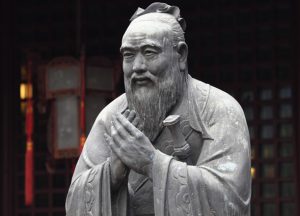 In teaching lessons of morality, early Chinese philosophers utilized illustrations from architecture. Perhaps best known among these philosophers was Confucius who believed the path through life was illuminated when people acted according their humanity. Ethics, morality, kindness, and truthfulness were among the teachings of his philosophy as he emphasized character development over a more traditional vocational based educational system.
In teaching lessons of morality, early Chinese philosophers utilized illustrations from architecture. Perhaps best known among these philosophers was Confucius who believed the path through life was illuminated when people acted according their humanity. Ethics, morality, kindness, and truthfulness were among the teachings of his philosophy as he emphasized character development over a more traditional vocational based educational system.
“A man should abstain from doing unto others what he would not they should do unto him; and this is called the principle of acting on the square.”
Confucius in Great Learning, 500 B.C.
Foremost among his predecessors, Mencius continued to utilize examples from the common man’s life in illustrating morality and virtue.
“A master Mason, in teaching his apprentices, makes use of the compasses and the square. Ye who are engaged in the pursuit of Wisdom, must also make use of the compasses and the square.”
Mencius, 300 B.C.
 The specific origin of Masonry cannot be definitively given as Masonry developed over a long period of time. Striking similarities are found in the Solar Mysteries of Egypt, which is believed to have evolved as early as 2000 B.C. Early Greek philosophers and poets Pythagoras, Plutarch, Plato, and Pindar were among the initiates of the Greater Mysteries, a repository of the highest learning of the time in astronomy, geometry, religion, the fine arts, and the laws of nature. In the following centuries the Roman Collegia emerged as small, local groups of artisans-goldsmiths, dyers, builders, potters, and other tradesmen. These groups acted upon petitions for membership, received members through initiations, divided the membership into grades, had common rooms and tables (much like those of modern fraternities), a charity fund, and used passwords, grips, tokens, and symbols to differentiate members from non-members. Each group was self-governing. The primary interest of these groups varied greatly; some were religious (often pagan) in nature, others were socially inclined, and some were based in a particular trade or profession.
The specific origin of Masonry cannot be definitively given as Masonry developed over a long period of time. Striking similarities are found in the Solar Mysteries of Egypt, which is believed to have evolved as early as 2000 B.C. Early Greek philosophers and poets Pythagoras, Plutarch, Plato, and Pindar were among the initiates of the Greater Mysteries, a repository of the highest learning of the time in astronomy, geometry, religion, the fine arts, and the laws of nature. In the following centuries the Roman Collegia emerged as small, local groups of artisans-goldsmiths, dyers, builders, potters, and other tradesmen. These groups acted upon petitions for membership, received members through initiations, divided the membership into grades, had common rooms and tables (much like those of modern fraternities), a charity fund, and used passwords, grips, tokens, and symbols to differentiate members from non-members. Each group was self-governing. The primary interest of these groups varied greatly; some were religious (often pagan) in nature, others were socially inclined, and some were based in a particular trade or profession.
The Guilds
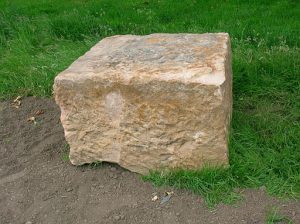 From the downfall of the Roman Empire in Late Antiquity through early in the Italian Renaissance, the structured order of civilization was diminished. Cultural and economic developments were made in Europe after this time and civilizations grew more organized. Among the primary features of this period of restoration was the development and training of skilled laborers. These craftsmen later formed into societies, called guilds, as further societal and cultural advancements were made. The guilds, much like the Roman Collegia, were comprised of men within a community and particular skill or trade. It is important to recall the printing press had not yet been developed and reading and writing were skills for the social elite and clergy. As such, a majority of the practical knowledge and learning of the time was done by word of mouth. Within a guild, the particular details of a trade were closely guarded and members were bound to maintain these secrets.
From the downfall of the Roman Empire in Late Antiquity through early in the Italian Renaissance, the structured order of civilization was diminished. Cultural and economic developments were made in Europe after this time and civilizations grew more organized. Among the primary features of this period of restoration was the development and training of skilled laborers. These craftsmen later formed into societies, called guilds, as further societal and cultural advancements were made. The guilds, much like the Roman Collegia, were comprised of men within a community and particular skill or trade. It is important to recall the printing press had not yet been developed and reading and writing were skills for the social elite and clergy. As such, a majority of the practical knowledge and learning of the time was done by word of mouth. Within a guild, the particular details of a trade were closely guarded and members were bound to maintain these secrets.
Masons (Operative)
The work of a stonemason largely consisted of constructing and erecting cathedrals, castles, and other large structures. These projects required many years, sometimes centuries, to complete. Given the amount of laborers and skills required to complete these projects, local guilds were inadequate. Unlike many of the other trades, where labors were done within a local area, it was necessary for stone masons to be migratory.
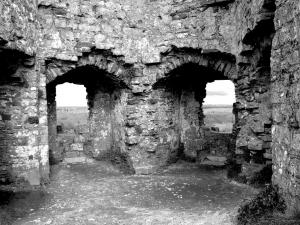 On commissioning a building or other work, an employer (generally the Church or Crown) would select a Master of the Work, as a highly skilled craftsman. The Master was then charged with selecting groups of workmen for the project and arranging for their travel from a previous construction site. The craftsmen, after establishing homes or barracks, would construct a workshop. In addition to being a work and storage area the workshop, called a Lodge, was a communal building in which the workmen could rest, dine and relax. Thus, the lodge became designated to describe both the building and the community of workmen working there in.
On commissioning a building or other work, an employer (generally the Church or Crown) would select a Master of the Work, as a highly skilled craftsman. The Master was then charged with selecting groups of workmen for the project and arranging for their travel from a previous construction site. The craftsmen, after establishing homes or barracks, would construct a workshop. In addition to being a work and storage area the workshop, called a Lodge, was a communal building in which the workmen could rest, dine and relax. Thus, the lodge became designated to describe both the building and the community of workmen working there in.
Originally, the term Mason was applied to any builder including quarrymen, wallers, hewers, slaters, tillers, rough masons, cutters, plasterers, carpenters, and any others working on the structure. Masonry referred to the craft as a whole. Those skilled craftsmen who were charged with overseeing the project (similar to modern architects or engineers) were well trained in engineering and geometry. As a result of their extensive experiences and talent, many were proficient in the various specialized and technical aspects of the building trade, including carving, sculpturing, the making of stained glass windows and mosaics. These craftsmen were called "Freemasons," perhaps because they were free to move as they desired, whereas the lesser workmen were generally serfs, and could travel only at the pleasure of their masters.
Freemasonry in America
Shortly after the formation of the Grand Lodge of England, the fraternity spread throughout Europe and the American Colonies. Freemasonry became very popular in colonial America. George Washington was a Mason, Benjamin Franklin served as the head of the fraternity in Pennsylvania, as did Paul Revere and Joseph Warren in Massachusetts. Other well-known Masons involved with the founding of America included John Hancock, John Sullivan, Lafayette, Baron Fredrick von Stuben, Nathanael Greene, and John Paul Jones. Another Mason, Chief Justice John Marshall, shaped the Supreme Court into its present form.
Over the centuries, Freemasonry has developed into a worldwide fraternity emphasizing personal study, self-improvement, and social betterment via individual involvement and philanthropy. During the late 1700s it was one of the organizations most responsible for spreading the ideals of the Enlightenment: the dignity of man and the liberty of the individual, the right of all persons to worship as they choose, the formation of democratic governments, and the importance of public education. Masons supported the first public schools in both Europe and America.
During the 1800s and early 1900s, Freemasonry grew dramatically. At that time, the government had provided no social "safety net". The Masonic tradition of founding orphanages, homes for widows, and homes for the aged provided the only security many people knew.
Freemasonry in Oklahoma
Interestingly, the foundation of Masonry in Oklahoma begins, in part, with the Native American of the Indian Territories. Belonging to Lodge’s in Washington, D.C. or Fort Smith, Arkansas, leaders of the relocated Native American tribes, as well as missionaries, army officers, merchants, and traders established Masonry in early Oklahoma. It is doubtless there were a number of Masons in the Indian Territory, however few as respected as Reverend Joseph Samuel Murrow. A Baptist minister, Father Murrow as he was known began his service in the Indian territories in November 1857. He became a Mason in 1866 while on sojourn in Texas and went on to found and be the first Worshipful Master of Oklahoma Masonic Lodge #217 in 1868, which was Chartered by the Grand Lodge of Arkansas.
Owing to the difficulties in both travel and communication during the time, the predominantly Native American brethren in eastern Oklahoma successfully petitioned the Grand Lodge of Arkansas for a dispensation to open a Lodge in Tahlequah. The charter for the first Lodge in the Indian Territory was issued on November 9, 1848 to Cherokee Lodge No. 21. Despite the destruction of records, the officers (all Native American) installed in 1849 included W.S. Adair, WM; N.B. Dannenberg, SW; Joseph Coody, JW; T.B. Emerson, SD; W.L. Held, J.D.; William P. Ross, Secretary; and David Carter, Treasurer. Like Cherokee Lodge No. 21, many of the early Lodges in the Indian Territory were predominantly Native American. The second lodge (Fort Gibson Lodge No. 35) was chartered on November 5, 1850, and was predominantly comprised of men posted at the Fort and post merchants. Despite the tensions existing between the Native American people and U.S. Government during the time, the lodges maintained peaceful relations. Subsequent Lodges were chartered by the Grand Lodge of Arkansas.
Civil War
Throughout the tremendous tensions of Civil War in the United States, the unifying ties of Masonry remained firm. There are numerous examples of Union and Confederate soldiers meeting in Masonic Lodges during lulls in the fighting. In the Indian Territory the Masonic lesson of governmental loyalty was challenged. Despite the best efforts of Native American leaders; Chief Ross (Cherokee), Chief Jumper (Seminole), Chief Pitchlyn (Choctaw), and Chief Hopothle Yahola (Creek), all of whom were Freemasons, the neutrality the Indian Nations maintained during the early periods of the Civil War became impossible. Eventually, having been largely abandon by the Union cause and with the Confederate states to the east, south and west, the Indian Nations signed treaties with the Confederacy. Many of these Masonic leaders practiced the Masonic virtues of temperance, justice, and prudence in their individual efforts during the period of war. Many of the pre-war Lodges had their Charters revoked.
The Reconstruction period found the lands and people of the Indian Nations devastated. In addition to the loss of relationship with the United States government, the westward expansion further injured the Indian Nations. However, this period allowed for the re-establishment of many lodges. Notably Rev. Joseph Murrow received a dispensation to open “Ok-la-ho-ma” Lodge at Bogey Depot in July, 1868. As the fraternal order continued its expansion, it provided structure and order in the communities it served.
Masonry in Stillwater
Freemasonry in Stillwater goes back to the days before statehood; back to our pioneer ancestors. Although no 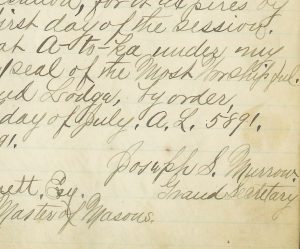 lodge existed in Stillwater, Masons were active in the Stillwater many years before a charter was issued. Charters are required for a Masonic lodge for it to be recognized and sanctioned by the Grand Lodge of that jurisdiction. Uniquely, Frontier Lodge has operated under three charters, the first under the Indian Territory Grand Lodge, the second under the Oklahoma Territory Grand Lodge and lastly, under the Grand Lodge of Oklahoma. On July 4, 1891, the Indian Territory Grand Lodge granted a dispensation allowing a group of Masons in Stillwater to meet with the objective of selecting a name for their lodge and apply for charter. J.S. Hunt lead this group and applied for a charter with "Frontier" as the lodge name. The Stillwater Lodge was given the number 48 as it was the 48th lodge to be chartered in the Indian Territory. The first record of minutes for the newly chartered lodge were dated July 15, 1891, under dispensation from the Indian Territory Grand Lodge. The minutes of this first meeting were entered and signed by Joseph S. Murrow, father of Oklahoma masonry!
lodge existed in Stillwater, Masons were active in the Stillwater many years before a charter was issued. Charters are required for a Masonic lodge for it to be recognized and sanctioned by the Grand Lodge of that jurisdiction. Uniquely, Frontier Lodge has operated under three charters, the first under the Indian Territory Grand Lodge, the second under the Oklahoma Territory Grand Lodge and lastly, under the Grand Lodge of Oklahoma. On July 4, 1891, the Indian Territory Grand Lodge granted a dispensation allowing a group of Masons in Stillwater to meet with the objective of selecting a name for their lodge and apply for charter. J.S. Hunt lead this group and applied for a charter with "Frontier" as the lodge name. The Stillwater Lodge was given the number 48 as it was the 48th lodge to be chartered in the Indian Territory. The first record of minutes for the newly chartered lodge were dated July 15, 1891, under dispensation from the Indian Territory Grand Lodge. The minutes of this first meeting were entered and signed by Joseph S. Murrow, father of Oklahoma masonry!
On October 2, 1891, District Deputy Grand Master A.J. Spiegel presented the charter and installed the new officers. J.S. Hunt was installed as the first Worshipful Master and served the last three months of 1891. Amos W. Swoope was elected Worshipful Master for the first full year of 1892. Meetings were held on the Friday before or after the full moon and on the 2nd Friday thereafter. Dues were $3 per year (probably the equivalent of $200 in today's economy). During that same year, the Oklahoma Territory Grand Lodge was formed. There were ten of the Indian Territory Lodges which fell under the jurisdiction of the newly formed Grand Lodge and the lodge in Stillwater received the designation of “Frontier Lodge No. 6”, along with a new charter. Minutes from the early days of Frontier Lodge indicate one thing: many men joined Masonry as there were many degrees being performed. At nearly every meeting, either a petition was being read or a degree was being conducted.
Lytton Building
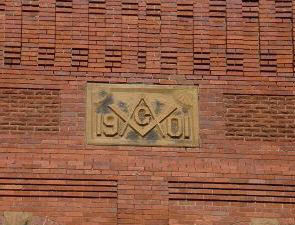 The Lytton building was the home of Masonry in Stillwater from October 30, 1901 until February 17, 1950. The original lodge building was located on Main Street and was shared by a number of groups in Stillwater. The Payne County Sheriff used the lodge room as the Grand Jury room for the County. Unfortunately, he got on the brother's wrong side by not straightening up after jury duty, and was assessed a $1 additional fee for janitorial services after a couple of warnings. Also sharing the building were Woodsmen of the World, Oddfellows, and Knights of Pythias. At one point, the lodge considered purchasing six cots so brothers could "bunk" at the lodge instead of traveling home late at night. That idea was eventually voted down. In August of 1893, the meeting nights were changed to 1st and 3rd Fridays of each month. After statehood in 1907, the two territorial Grand Lodges consolidated to become the “Grand Lodge of Oklahoma”. By agreement of the two territorial lodges, the ten lodges had their original numbers restored to them. After that, the Stillwater Lodge went from “Frontier Lodge No. 6” back to “Frontier Lodge No. 48”.
The Lytton building was the home of Masonry in Stillwater from October 30, 1901 until February 17, 1950. The original lodge building was located on Main Street and was shared by a number of groups in Stillwater. The Payne County Sheriff used the lodge room as the Grand Jury room for the County. Unfortunately, he got on the brother's wrong side by not straightening up after jury duty, and was assessed a $1 additional fee for janitorial services after a couple of warnings. Also sharing the building were Woodsmen of the World, Oddfellows, and Knights of Pythias. At one point, the lodge considered purchasing six cots so brothers could "bunk" at the lodge instead of traveling home late at night. That idea was eventually voted down. In August of 1893, the meeting nights were changed to 1st and 3rd Fridays of each month. After statehood in 1907, the two territorial Grand Lodges consolidated to become the “Grand Lodge of Oklahoma”. By agreement of the two territorial lodges, the ten lodges had their original numbers restored to them. After that, the Stillwater Lodge went from “Frontier Lodge No. 6” back to “Frontier Lodge No. 48”.
School House - Current Location
In February 1950, Frontier Lodge No. 48 moved to its current location at 322 W. Miller Street. The lodge building was a schoolhouse at one time. The lodge room was an auditorium, the East was the stage and, until recently, there was a hole over the Senior Warden's station where the projector was located for showing movies.
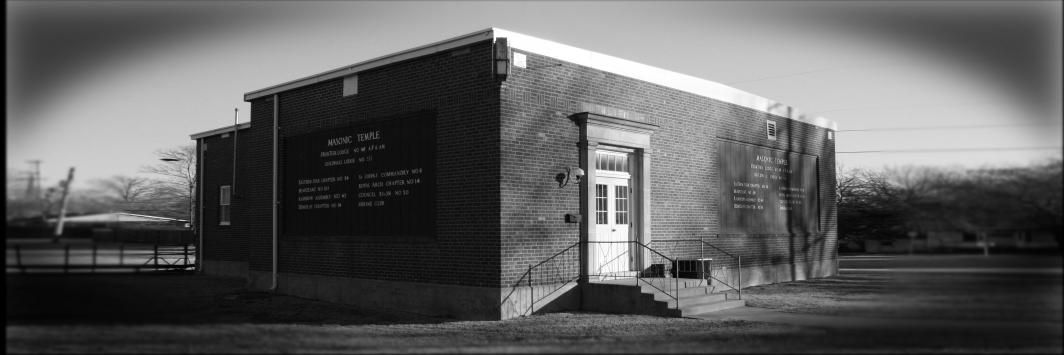
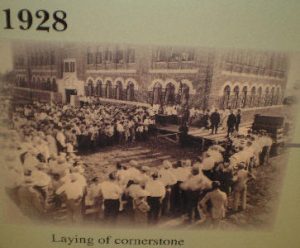
The lodge had, and has, a close relationship with Oklahoma State University. Many of its past and present members were students, faculty and staff at the school. In 1928, Frontier Lodge assisted the Grand Lodge of Oklahoma and the governor with a cornerstone ceremony at the Dairy Building on campus (the time capsule from that ceremony was opened in 2007, shortly after the Dairy Building was demolished). Over the years, Frontier Lodge has been the Masonic home for many OSU faculty, staff, and students.


